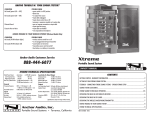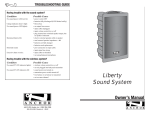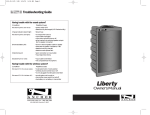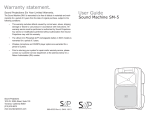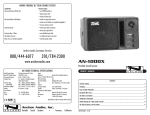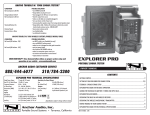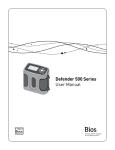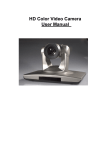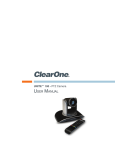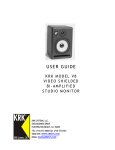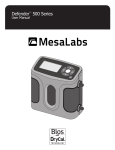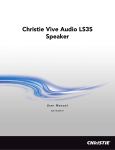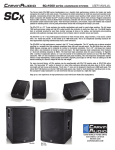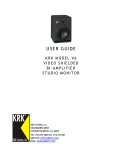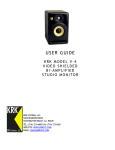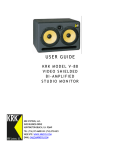Download User Manual
Transcript
TROUBLESHOOTING GUIDE Having trouble with the sound system? Condition Possible Cause No sound (power LED not lit): • • • • • • • • • • No sound (power LED lights): Distorted sound: Excessive hum or noise: power switch OFF blown fuse no output from source input cable unplugged input volume control low or off accessory or expansion module not in option bay poor or improper connection on input cable input signal too strong input cable not shielded not using balanced microphone Having trouble with the wireless system? Condition Possible Cause No sound (TX ON indicator lights): • • • • • No sound (TX ON indicator off): wireless volume control low or off no mic plugged into belt-pack transmitter sound system not turned on transmitter power switch turned off low battery or no battery in transmitter Xtreme Sound System Owner’s Manual ANCHOR Audio, Inc. (310) 784-2300 100-0135-000 / Revision A - 09/03 IMPORTANT SAFEGUARDS SPECIFICATIONS Xtreme CAUTION: To reduce the risk of electric shock, do not remove the cover. No user-serviceable parts inside. Refer servicing to qualified personnel. WARNING: To prevent fire or electric shock, do not expose this equipment to rain or moisture. Rated power output Stand-alone low frequency amp: high frequency amp: Max SPL @ rated power: CAUTION: To reduce the risk of fire, replace only with same type fuse (see specifications). w/XTR-6001 companion 90 watts 40 watts 125 watts 55 watts 116 dB speech projection out, 123 dB speech projection in General ATTENTION: Pour eviter les risques de choc électrique, ne pas enlever le couvercle. Aucun entretien de pièces intérieures par l'usager. Confier l'entretien au personnel qualifié. AVIS: Pour eviter les risques d'incendie ou d’électrocution, n'exposez pas cet article à la pluie ou a l'humidité. ATTENTION: Pour diminuer le risque d’incendie, remplacer par des fusibles de même type (voir caractéristiques). EXPLANATION OF GRAPHICAL SYMBOLS The lightning flash with arrowhead symbol, within an equilateral triangle, is intended to alert the user to the presence of uninsulated “dangerous voltage” within the product’s enclosure that may be of sufficient magnitude to constitute a risk of electric shock to humans. Frequency response: 80 Hz - 15 kHz (speech projection in: +7 dB from 2 -12 kHz) Bass/Treble control: 8 db cut/boost @ 100 Hz, 8 kHz Inputs Line input: 1/4” phone, Hi-Z, unbalanced Mic input: XLR female, Lo-Z +12VDC condenser mic power Balanced input: XLR female, switchable mic/line level +12VDC condenser mic power Sensitivity for rated output Unbalanced line: -18 dBV (125 mVrms) The exclamation point, within an equilateral triangle, is intended to alert the user to the presence of important operating and maintenance (servicing) instructions in the literature accompanying the appliance. Balanced mic: -58 dBV (1.25 mVrms) Balanced mic input: -58 dBV (1.25 mVrms) EXPLICATION DES SYMBOLES GRAPHIQUES Balanced line input: -15 dBV (175 mVrms) Le symbole éclair avec point de flèche à l'intérieur d'un triangle équilatéral est utilisé pour alerter l'utilisateur de la presence à l'intérieur du coffret de “voltage dangereux” non isolé d'ampleur suffisante pour constituer un risque d'elétrocution. Line output (post fader): XLR male, 600Ω, active balanced Speaker Output: 4-pole Neutrik Speakon® jack for use with Anchor XTR-6001 AC power requirements: 110 - 125 VAC, 50/60 Hz, 250 watts max. or (factory configurable) 210 - 240 VAC, 50/60 Hz, 250 watts max. (250 watts maximum) Dimensions (HWD): 22.5 x 13 x 10", 57 x 33 x 26 cm Weight: 35 pounds, 16 Kg. Le point d'exclamation à l'intérieur d'un triangle équilatéral est employé pour alerter les utilisateurs de la présence d'instructions importantes pour la fonctionnement et l'entretien (service) dans le livret d'instruction accompagnant l'appareil. DATE OF MANUFACTURE The date of manufacture of this Anchor Audio product can be determined by the six digit serial number code. The 1st digit denotes the month (A=Jan, B=Feb, etc.), the 2nd digit denotes the year. Example: “H20142” states that the unit was manufactured in August of 2002. Specifications subject to change without notice. 13 ACCESSORIES XTR-6001 Dual function (speech projection on/off) unpowered companion speaker for the Xtreme Sound System (Speaker cable not included) SC-50NL Heavy duty 50' speaker cable SS-550 Heavy duty brushed aluminum speaker stand MSB-201 Microphone floor stand with 33" adjustable boom Thank you for choosing an Anchor Audio portable sound system. Our products incorporate state-ofthe-art design and the finest quality of materials and workmanship. We’re proud of our products and appreciate the confidence which you have shown by selecting an Anchor system. I hope you’ll take a few of minutes to review this manual. We’ve incorporated several unique features into our products, and your knowledge of how to use them will enhance the performance and your enjoyment of the system. NL-6000 Heady duty storage cover for Xtreme FL-4500 Admiral floor model lectern with a center console to accommodate a Xtreme sound system, includes a shock-mounted mic input David Jacobs, President on behalf of all Anchor Employees MIC-90 Dynamic, balanced, low impedance handheld microphone with unidirectional pick-up pattern, on/off switch, 20' cable and mic clip WH-6000 Handheld wireless microphone/ transmitter WB-6000 Wireless body-pack transmitter (order mic separately) CONTENTS Getting Started ………………………………………2 Precautions ……………………………………………3 System Setup ………………………………………4-5 General Operation …………………………………6-8 CD Player Operation …………………………………9 CM-60 CollarMic microphone (use with WB-6000 transmitter) Wireless Operation ……………………………10-11 Accessories …………………………………………12 HBM-60 Specifications ………………………………………13 Headband microphone (use with WB-6000 transmitter) Troubleshooting Guide……………………back cover LM-60 Lapel microphone (use with WB-6000 transmitter) 12 1 GETTING STARTED WIRELESS OPERATION System Inspection & Inventory Check unit carefully for damage which may have occurred during transit. Each Anchor product is carefully inspected at the factory and packed in a special carton for safe transport. Inventory NOTE: All damage claims must be made with the freight carrier. • Xtreme sound system • Warranty registration card All damage claims must be made with the freight carrier. Notify the freight carrier immediately if you observe any damage to the shipping carton or product. Repack the unit in the carton and await inspection by the carrier’s claim agent. Notify your dealer of the pending freight claim. Returning Systems For Service or Repair IMPORTANT: Save the shipping carton and packing materials. They were specially designed to ship your unit safely. Should your unit require service, contact your dealer or the Anchor Audio Customer Service Department at (800) 262-4671 to obtain a Return Authorization (RA) number. All shipments to Anchor Audio must include an RA number and must be shipped prepaid. C.O.D. shipments will be refused and returned at your cost. Warranty Registration Please fill out the warranty card and return it with a copy of your invoice to Anchor’s Customer Service Department. This will activate your limited six year warranty. Wireless Microphone Operation NOTE: When using a dual wireless unit, make sure each microphone is set to a different channel frequency. Both the receiver and microphone must be set to the same channel. 1. If you are using a body-pack transmitter, insert the plug from the mic into the jack marked MIC on the transmitter. 2. Turn the transmitter power switch to ON. (The red LED will flash when the mic is turned on. If the red LED stays on, the battery is low.) 3. Turn the Xtreme power switch to ON. 4. The RX indicators will light (one indicator at a time lights) when the wireless signal is being transmitted and received. Replacing Transmitter Battery CAUTION: Harmful feedback may occur when walking in front of a sound system or speaker with a wireless microphone. Always point mic away from speakers. Handheld Transmitter: 1. Unscrew battery compartment cover on lower end of mic. 2. Install 2 fresh ‘AA’ alkaline batteries. 3. Replace the battery cover. Place batteries into slot and slide forward Body-pack Transmitter: 1. Slide open battery cover on front of transmitter box. 2. Install 2 fresh ‘AA’ alkaline batteries. 3. Close the battery cover. NOTE: Transmitter power switch must be in the OFF position when changing batteries 2 11 WIRELESS OPERATION PRECAUTIONS Diversity Wireless by Anchor Audio Feedback Anchor Audio UHF wireless is a 16 channel, diversity wireless system that utilizes two independent antennae to receive signal. The diversity feature means that the receiver will process the stronger of the two antenna signals, effectively minimizing dropouts and interference from other transmitting sources. The antennae are mounted internally so there are no obstructions or risk of damage. Feedback is a howling or shrill sound that is self-generated by the sound system. It is caused by microphone pickup of the sound emanating from the speaker and then being re-amplified. Once generated, this can be a self-sustaining phenomenon. Feedback Causes Receiver Channel Selection NOTE: If you experience ongoing interference with your wireless system, the selected frequency may be incompatible with other RF systems in your area. Try a different channel. Before you use your UHF wireless system, you will need to select a wireless frequency channel. The wireless receiver is mounted inside the Xtreme and can be set to any of 16 available channels. Transmitter Channel Selection Handheld Transmitter: 1. Unscrew battery cover on lower end of microphone. 2. Set the channel selection dial to match the channel setting on the receiver. Microphone too close, pointing towards or in front of speaker. • Volume setting too loud for room. • Sound reflections from hard surfaces, walls, etc. Avoiding & Eliminating Feedback 1. Locate the Wireless Channel selector on the back panel. 2. Set the Channel (frequency) of the receiver to 1 thru 16. • CAUTION: Feedback can be damaging to both your equipment and a persons hearing. • Point the microphone into a different direction. • Keep the microphone away from the speaker; position the speaker in FRONT of the microphone. • Reduce the volume of the sound system. Have all volume controls set to minimum prior to powering on the sound system. • Place sound dampening material over hard surfaces; curtains or sound dampening foam. 3. Replace the battery cover. Body-pack Transmitter: NOTE: Be sure that the MIC/LINE switch is in the “MIC” position when a mic is plugged into the body-pack transmitter. 10 1. The channel selection dial is located on the side of the transmitter. 2. Set the channel selection dial to match the channel setting on the receiver. Acceptable Unacceptable 3 SYSTEM SETUP CD OPERATION Setting Up The Xtreme Sound System For best results, it is recommended that the sound system be placed above the heads of the audience and above the height of the tallest obstruction using a speaker stand or table. This will benefit the listeners in the rear while minimizing the risk of overpowering the listeners in front. CAUTION: To avoid noise at shut off, turn CD player off before you turn off the Xtreme. CD Slot LCD Display Power On/Off General Operation Stand Setup 1. Loosen the Lower Collar Knob. Upper Collar Knob 2. Separate the stand legs until the leg support cross braces are parallel to the floor. INSERT CD - Push a disc into the CD slot label side up. The disc will automatically insert and begin to play. POWER ON/OFF - Press POWER to turn the unit on and off. Lower Collar Knob 3. Tighten the Lower Collar Knob. 4. Extend the center pole by loosening the Upper Collar Knob. 5. Adjust the height and retighten the Upper Collar Knob. 6. Place the Anchor sound system on the stand. The CD player features direct-in play power loading, anti-shock/skip CD mechanism, repeat & random play, three beam laser tracking system and dual one bit D/A converters. The audio signal is fed directly into the mixing bus, mixing it directly with all other inputs of the Xtreme for a composite output. Cross Braces Sound System Placement The ideal placement of the sound system is between the crowd and the presenter, facing the crowd. This will give the audience a direct signal path and keep the person with the microphone behind the sound system, helping to prevent feedback from occurring. Single Unit Application Place the unit along the aisle with the least amount of pedestrian traffic. Point the unit towards the center of the audience. EJECT CD - Press EJECT to eject the disc from the slot. If the disc has not been removed within 10 seconds, it will automatically be loaded into the slot again. PLAY/PAUSE - Press to play a disc if one has been loaded. Press this button while disk is playing to pause play, press again to resume. UP - Press UP once to advance disc to next track. Press and hold UP to fast forward on the current track. DOWN - Press DOWN once to go to previous track. Press and hold DOWN to fast backward on current track. TOP - Press TOP once to start playing the disc from the first track. RANDOM - Press RDM to play all the tracks continuously in random order. Press RDM again to stop continuos random play. REPEAT - Press this button to repeat the same track of the disc continuously. RPT Will appear on the display, press again to stop it. 4 9 GENERAL OPERATION SYSTEM SETUP Speaker Out Two Unit Application The Speaker Out on the Xtreme is a biamped output (separate amplifier for each of the high and low frequencies) intended for use with the XTR-6001 unpowered companion speaker. Place each unit along the aisles pointing just off the centerline of the audience. With the sound system placed properly over the head of the crowd, this should be sufficient coverage. Speech Projection LIECHTENSTEIN The Speech Projection switch allows you to customize the sound output of the Xtreme for a particular application: Speech Projection off (button out): The Xtreme provides flat, full-range frequency response for music or indoor voice applications. High School Football Stadium/Stands Speech Projection on (button in): Frequencies in the vocal range (800Hz-12kHz) are boosted for added clarity and efficient sound projection. Use this setting for outdoor functions, large crowds and speech applications. Auditorium / Outdoor Assembly/City Hall Sound System Connection NOTE: Auditoriums or outside areas with large exposed walls or patios may create multiple reflections of the original sound. Altering the sound system position will minimize the sound reflections. There are two ways of connecting two or more Xtreme sound systems together. The simplest method would be to use the speaker output of the primary unit and connect it to the unpowered companion speaker using an SC-50 speaker cable. No electric power is required for an unpowered companion speaker. The second method would be to utilize the line-output feature. Simply connect a (EX-50PP) cable from the line-out of the primary Xtreme to the line-in on the secondary powered Xtreme. Set the volume of the second Xtreme to maximum so that full volume control will be at the primary sound system. Secondary Powered Xtreme System Primary Powered Xtreme System Line Out - to - Line In Connection The line-out connection can also be used to send the signal to a sound system in a different room or a recording device. 8 5 GENERAL OPERATION Xtreme Control Panel NOTE: Instructions for wireless operation can be found on pages 10 & 11. Line In 1. Set all input level controls to minimum and tones controls to flat or middle position before turning on the power. 2. Plug a microphone into Mic 1 or Mic 2, or plug an audio source into the Line-in input jack. 3. Press POWER on. The red LED near the switch will light. 4. Slowly increase the level control adjacent to the input jack used to desired volume. 5. For speech applications, Speech Projection should be “on” to overcome ambient noise. For standard applications (music and indoors), Speech Projection should be “off”. 6. Adjust Bass and Treble controls for desired sound quality. Wireless Receiver Controls NOTE: All audio connections must be made with shielded cable to avoid hum, buzzing or radio interference. CD Player Speech Projection Switch CD Volume Tone Controls Balanced Line Out (XLR Jack) Line In (1/4” Phone Jack) Mic In (XLR Jack) Speaker Output Condenser Mic Power Switch Balanced Input (XLR Jack) Input Level Controls Mic In This balanced XLR, low impedance input is for use with balanced microphones to help prevent hum or interference when using long cables. It features +12VDC condenser mic power for use with condenser-type microphones. Balanced Input This balanced XLR, low impedance input can be used for either a balanced line level input or for a balanced microphone input. The Input Level and Condenser Mic Power features are user selectable. For a microphone level input, set the Input Level button to the "in" position. For line level sources, the Input Level button should be in the "out" position. For condenser microphones, set the Condenser Mic Power button to the “in” position; the "in" position supplies +12VDC at the input. Setting the button to the "out" position supplies 0V for all other input applications. Balanced Line Out The Balanced Line-out provides a combined signal of all inputs being used. You can use this function to record your presentation or to "daisy chain" another powered sound system to the Xtreme for greater crowd coverage. Note: This output is post source level; any volume fluctuations for a specific input will affect the output signal level at this output. NOTE: A balanced microphone (Lo-Z) is preferred for use with long cables, to minimize hum and interference. Condenser Mic Power is only required when using mics with a condenser element; in all other instances, the Condenser Mic Power switch should be set to off. Power Switch 6 This unbalanced, high impedance, input is used for playback of a cassette or CD player, musical instrument, VCR, other sound system or similar line-level signal source. This input may be used in conjunction with other inputs for a composite output. AC Inlet Input Level Switch XTR-6000CU2 Back Panel GENERAL OPERATION Fuse 7








